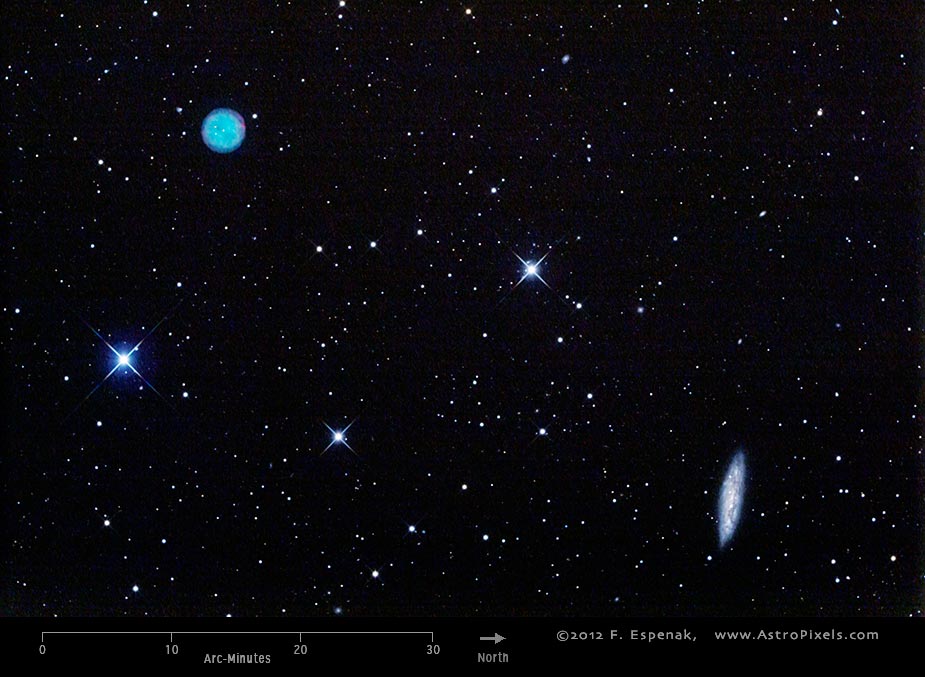M97 and M108
M97 and M108 are a pair of deep sky objects separated by approximately 50 arc minutes and located in the constellation Ursa Major. The close pairing is a cosmic coincidence since they are not physically associated with each other. M97 is a planetary nebula in our own galaxy while M108 is a spiral galaxy over ten thousand times more distant.
M97 and M108 are best seen during the spring. The Messier Spring Star Chart shows the position of all Messier objects visible during that season.
The image above shows the uncropped view of M97 (left) and M108 (right) through the ASA N12 Corrected Newtonian Astrograph (North is to the right). For another image of this pair using the Takahashi E-180 Astrograph, see M97 and M108 (TAK E-180) .
M97 - Owl Nebula
Messier 97 or M97 (also designated NGC 3587) is a planetary nebula in the constellation Ursa Major. It has an apparent visual magnitude of 9.9 and its angular diameter is 3.4x3.3 arc-minutes. M97 lies at an estimated distance of 2600 light years. The Equinox 2000 coordinates are RA= 11h 14.8m, Dec= +55° 01´. As one of the more famous objects in the Messier Catalog, it is commonly known as the Owl Nebula.
M97 was discovered by P. Méchain in 1781. It is one of only four planetary nebulae in the Messier Catalog (M27, M57, M76, and M97). The name "Owl Nebula" is attributed to the 3rd Earl of Rosse who applied it M97 in 1848. According to Stoyan et al. (2010), the distance of this planetary nebula is 4140 light years and its diameter is 3.5 light years. Its estimated age is 6,000-12,000 years.
M97 lies just 50 arc minutes southwest of the spiral galaxy M108. For more information on M97, see the Messier Catalog as well as specific entries for M97 in Wikipedia and SEDS.
M108
Messier 108 or M108 (also designated NGC 3556) is a spiral galaxy in the constellation Ursa Major. It has an apparent visual magnitude of 10 and its angular diameter is 8x1 arc-minutes. M108 lies at an estimated distance of 45 million light years. The Equinox 2000 coordinates are RA= 11h 11.5m, Dec= +55° 40´.
This nearly edge-on spiral galaxy was discovered by P. Méchain in 1781. According to Stoyan et al. (2010), the distance of M108 is 46.0 million light years and its diameter is 100,000 light years.
M108 lies just 50 arc minutes northeast of the planetary nebula M97. For more information on M108, see the Messier Catalog as well as specific entries for M108 in Wikipedia and SEDS.
Technical Details
- Objects: M97 and M108
- Other Names: M97: NGC 3587, Owl Nebula; M108: NGC 3556
- Object Type: Planetary nebula (M97) and spiral galaxy (M108)
- Object Data: M97: Apparent Magnitude = 9.9, Angular Size = 3.4x3.3 arc-minutes;
M108: Apparent Magnitude = 10, Angular Size = 8x1 arc-minutes - Object Position (Equinox 2000): M97: RA= 11h 14.8m, Dec= +55° 01´
M108: RA= 11h 11.5m, Dec= +55° 40´, Constellation = Ursa Major - Date/Time: 2012 Mar 23 at 04:07 UTC
- Location: Bifrost Astronomical Observatory, Portal, AZ
- Mount: Astro-Physics 1200GTO
- Telescope: ASA N12 Corrected Newtonian Astrograph
- Camera: Canon EOS 550D (Rebel T2i) (modified with a Baader UV/IR filter)
- Field of View: 71.0 x 47.4 arc-minutes at 0.82 arc-sec/pixel (web version: 4.6 arc-sec/pixel)
- Exposure: 8 x 480s, f/3.6, ISO 800
- File Name: M97M108-A01w.jpg
- Processing (Adobe Camera Raw): Flat Field Subtraction, Noise Reduction, White Balance
- Processing (Photoshop CS5): Average Images, Curves, Noise Reduction, High Pass Filter, Unsharp Mask
- Original Image Size: 3454 × 5179 pixels (17.9 MP); 11.5" x 17.3" @ 300 dpi
- Rights: Copyright 2012 by Fred Espenak. All Rights Reserved. See: Image Licensing.
